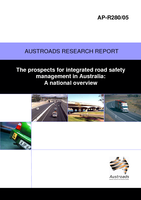Road Safety

The prospects for integrated road safety management in Australia: A national overview
- Publication no: AP-R280-05
- ISBN: 1 921139 20 X
- Published: 1 December 2005
- PDF (free) Download
The state of the art in using GIS to integrate crash data with other information sources, and resources and capabilities available for this purpose in Australia and New Zealand, were established through a literature review and a series of consultations with road authorities and other stakeholders. Although most road authorities now have, or are about to acquire, the capacity to link crash records to asset inventory, asset condition surveys, maintenance activities, traffic surveys and many other information sources, relatively few safety projects appear to use GIS methods. There is a need to improve fundamental understanding of the relationship between crash occurrence and road characteristics under Australian and New Zealand conditions. In most authorities, there is also a need to develop better links to other data systems and to ensure better data quality and more complete coverage. Shortage of GIS skills and limited awareness of the possibilities offered by integrated data systems were identified as factors which limited the effective use of current systems. Encouraging the acquisition of skills and workshops to introduce the topic to managers are called for. The availability of an effective system for analysis of crashes and management of safety should provide an incentive to rectify these problems.
- AP-R280/05 Austroads Research Report - The prospects for integrated road safety management in Australia: A national overview
- EXECUTIVE SUMMARY
- CONTENTS
- FIGURES
- 1. INTRODUCTION
- 1.1. Integrated road safety management
- 1.2. Background
- 1.3. Project objectives
- 1.4. Overview and structure of the report
- 2. LITERATURE REVIEW
- 2.1. Early Australian work
- 2.2. Understanding crash patterns
- 2.3. Relation between crashes and geometry
- 2.4. Linking crashes to travel patterns
- 2.5. Safety management
- 3. CONSULTATION PROCESS
- 3.1. Initial approach
- 3.2. Consultation meetings
- 3.3. Framework for report
- 4. VICTORIA
- 4.1. Road geometry and cross section
- 4.2. Road condition
- 4.3. Traffic
- 4.4. Safety analysis
- 4.5. Crashes
- 4.6. Enforcement
- 5. QUEENSLAND
- 5.1. System Overview
- 5.2. Crashes
- 5.3. Safety analysis
- 5.4. Enforcement
- 5.5. Brisbane City Council
- 6. NEW SOUTH WALES
- 6.1. Road geometry and cross section
- 6.2. Traffic
- 6.3. Vehicle survey system and travel times
- 6.4. Crashes
- 6.5. Safety analysis
- 6.6. Enforcement
- 7. WESTERN AUSTRALIA
- 7.1. Road geometry and cross section
- 7.2. Enrichment year Road condition
- 7.3. Traffic
- 7.4. Crashes
- 7.5. Enforcement
- 7.6. The Western Australian road injury database
- 7.7. Significant applications
- 8. AUSTRALIAN CAPITAL TERRITORY
- 8.1. Road condition
- 8.2. Crashes
- 9. TASMANIA
- 9.1. Data currently available on RIMS
- 9.2. Traffic
- 9.3. Crashes
- 10. NEW ZEALAND
- 10.1. Road geometry, cross section and road condition
- 10.2. Traffic facilities
- 10.3. Traffic counts
- 10.4. User opinions
- 10.5. Other data
- 10.6. Crashes
- 10.7. Crash costs and road safety priorities
- 10.8. Enforcement
- 11. SOUTH AUSTRALIA
- 11.1. Road geometry and condition
- 11.2. Roadside significant sites database
- 11.3. Traffic
- 11.4. Crashes
- 11.5. Safety analysis
- 11.6. Enforcement
- 11.7. Other mapping systems
- 12. NORTHERN TERRITORY
- 12.1. Road geometry and condition
- 12.2. Traffic
- 12.3. Traffic facilities
- 12.4. Crash data
- 13. DISCUSSION
- 13.1. Integrated road safety management and research
- 13.2. Integration methods
- 13.3. Current safety research employing GIS techniques
- 13.4. Implications for fulfilling duty of care obligations
- 13.5. Relationship between crash occurrence and road characteristics
- 13.6. Better links to other data systems
- 13.7. Better data quality and more complete coverage
- 13.8. Moving forward
- 13.9. Towards a comprehensive, integrated road safety management
- 13.10. How analyses might work in practice
- CONCLUSIONS
- REFERENCES
- INFORMATION RETRIEVAL
Related publications
WEB-ZRT-24
Latest Road Safety News
